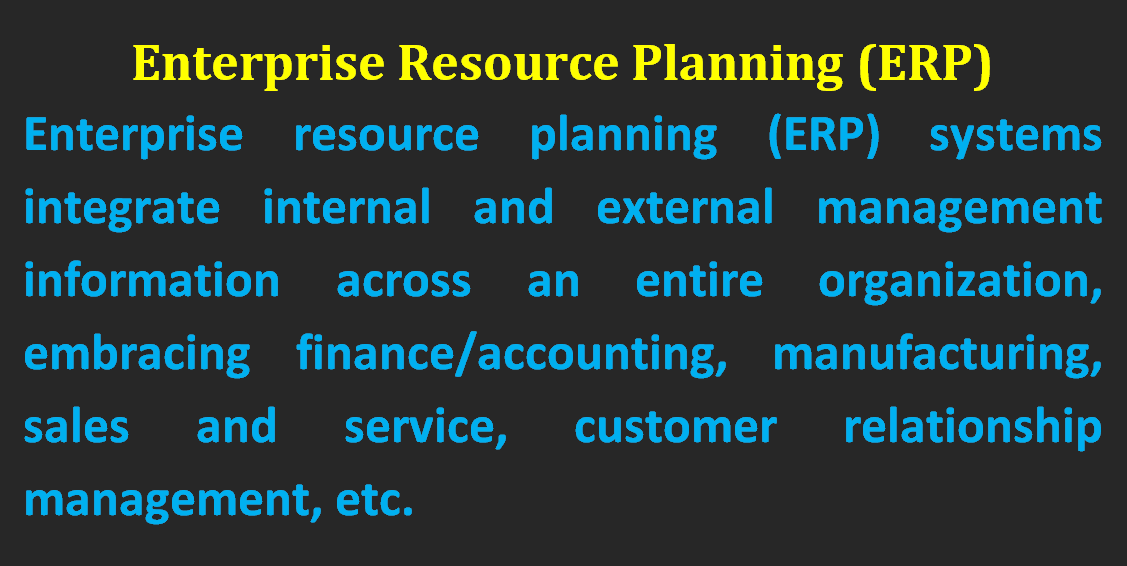Enterprise resource planning (ERP) systems integrate internal and external management information across an entire organization, embracing finance/accounting, manufacturing, sales and service, customer relationship management, etc.
ERP systems automate this activity with an integrated software application. Their purpose is to facilitate the flow of information between all business functions inside the boundaries of the organization and manage the connections to outside stakeholders.
ERP (Enterprise Resource Planning)
Enterprise resource planning (ERP) is business management software—usually a suite of integrated applications—that a company can use to collect, store, manage and interpret data from many business activities, including:
- Product planning, cost
- Manufacturing or service delivery
- Marketing and sales
- Inventory management
- Shipping and payment
Imagine that your enterprise is Warehouse providing. What is your main goal? To have a lot of staff at your Warehouse at maximum amount of time. But if your enterprise has Warehouse plus selling stores, then your priorities will change. You’ll try your best to have enough ( but not to much ) staff in your warehouses and majority of staff at your store. If you have big enough warehouse and stores you also need to plan what you will order and from whom. For example if you have store that sell winter sport staff, you will plan when you’ll hire additional people for selling, when you’ll send them for vacation, when you’ll spend money for advertising, etc. As another option you can sell winter sport staff in different hemispheres of Earth or concentrate at always winter areas. This list can grow and grow bigger.
Another example of enterprise resource planning can be taxi providing company. In that case you’ll need to plan when you’ll organize a lot of free cars, in which cities, in which parts of the city. Or when you’ll organize small amount of cars. Another area of planning will include how you can stimulate taxi drivers and when you can decrease size of reward for taxi drivers.
With all of this I can say that there are plenty of software that can help you to plan different kinds of enterprises. If you consider different ERP systems take a look at Acumatica.
Best Implementation of Enterprise Resource Planning
By a solid team of software consultants working in combination with your internal project team.
You’ll want to focus on two things: getting the right external partner and training up your internal team.
There’s change management, incentive alignment, user training, adoption, all are critical.
But most of all, start with the end in mind: If ERP is going to save you $10m in inventory issues, concentrate on learning all you can about inventory practices and hopefully you’ve selected an ERP package with a strong inventory module.
It’s really up to your internal team – but driving everything is knowing the value – if the project is going to save $10m it’s OK to send a couple of your inventory managers to a site visit where they’re already using the system for inventory excellence – that three week training course may look expensive, but if $10m is at stake, it’s a bargain – all those decisions stem from the value you’re working to implement – and just like any other goal, you’ll never get there until you quantify it and move toward it.
Limitations of Enterprise Resource Planning
Limitations of ERP (Enterprise Resource Planning) Systems:
- The cost of ERP Software, planning, customization, configuration, testing, implementation, etc. is too high.
- ERP deployments are highly time-consuming – projects may take 1-3 years (or more) to get completed and fully functional.
- Too little customization may not integrate the ERP system with the business process & too much customization may slow down the project and make it difficult to upgrade.
- The cost savings/payback may not be realized immediately after the ERP implementation & it is quite difficult to measure the same.
- The participation of users is very important for successful implementation of ERP projects – hence, exhaustive user training and simple user interface might be critical. But ERP systems are generally difficult to learn (and use).
- There maybe additional indirect costs due to ERP implementation – like new IT infrastructure, upgrading the WAN links, etc.
- Migration of existing data to the new ERP systems is difficult (or impossible) to achieve. Integrating ERP systems with other stand alone software systems is equally difficult (if possible). These activities may consume a lot of time, money & resources, if attempted.
- ERP implementations are difficult to achieve indecentralized organizations with disparate business processes and systems.
- Once an ERP systems is implemented it becomes a single vendor lock-in for further upgrades, customizations etc. Companies are at the discretion of a single vendor and may not be able to negotiate effectively for their services.
- Evaluation prior to implementation of ERP system is critical. If this step is not done properly and experienced technical/business resources are not available while evaluating, ERP implementations can (and have) become a failure.
Pros & Cons of ERP implementation
The pros & cons depend on which ERP software you are using. There are lots of ERP software available in the market and every software has unique pros & cons.
Below I mention some common Pros & Cons of ERP Implementation:
- Pros:
- Gives the real-time value of data
- Reinforced Data Security
- POS System
- Pricing and discounts management
- Cons
- Some software is very expensive
- Need experts to run ERP software
I hope this will help you.
